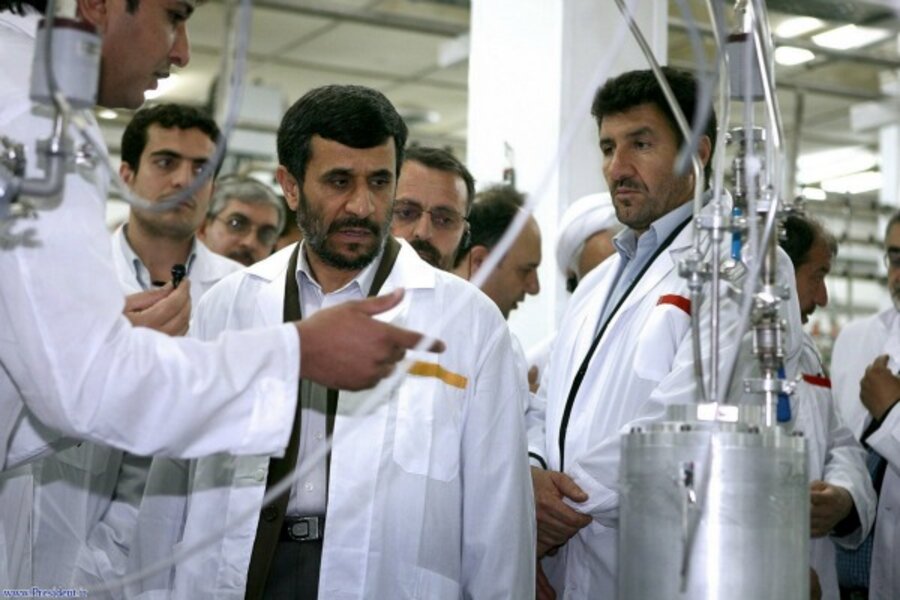Senate resolution on Iran may be bipartisan, but it could lead to war
Loading...
| Arlington, Va.
A Senate resolution on Iran is being touted by its bipartisan cosponsors as a way to “put to rest any suspicion” that the United States would acquiesce to a nuclear-capable Iran.
The tough tone is admirable, but the resolution, which awaits action in the Senate Committee on Foreign Relations, is seriously flawed. Although non-binding, this resolution expressing the sense of the Senate confuses the issue and is simply bad policy.
Cosponsored by Democrat Robert Casey of Pennsylvania, Republican Lindsey Graham of South Carolina, and Independent Joe Lieberman of Connecticut, the resolution calls on the president to “reaffirm the unacceptability of an Iran with nuclear-weapons capability.” And it has him “oppose any policy that would rely on containment as an option in response to the Iranian nuclear threat.”
As a retired Air Force colonel with experience as a student, instructor, and practitioner in the national security arena, I have two major concerns about this document, although I also see a silver lining.
One issue is the definition of “nuclear weapons capability.” There is a vast difference between having the capability to produce nuclear weapons and actually doing so.
It is not irrational to argue that Iran already possesses “nuclear weapons capability” and has had it for some years. The Iranians possess the uranium and the ability to enrich it and may be nearing a plutonium reprocessing capability. They certainly have the scientific and technical expertise to produce a weapon given the time and a political decision to do so.
The resolution also calls for “the full and sustained suspension of all uranium enrichment-related and reprocessing activities.” In other words, it would seem to have Iran give up most if not all of its nuclear programs, peaceful and otherwise.
There is a legitimate dispute as to whether Iran has the right under the nonproliferation treaty (NPT) to have full nuclear fuel cycle capability. But this dispute must be decided by negotiation, not a resolution.
Iran is an NPT signatory but has not fully complied with International Atomic Energy Agency (IAEA) inspection and other procedures. A negotiated agreement wherein Iran retains a civilian nuclear program, as it is entitled to under the NPT with IAEA inspections and safeguards, would resolve this dispute and ease fears of an Iranian nuclear weapons program.
But the resolution has another problem beyond the capability issues. It asserts that containment is not an acceptable outcome. President Obama has already made this clear, so why object to the resolution?
The short answer is that the document adds nothing on this point and, more importantly, could be taken to authorize the use of force if Iran gets a nuclear weapon. The resolution blocks a containment strategy and endorses US military action regardless of any other circumstances.
To be clear, an Iran with nuclear weapons is a regional and global danger. But so is nuclear Pakistan, a state from which more terrorist attacks have been launched over the past decade than Iran.
When the Soviet Union and China became nuclear-weapons states, the US had to develop containment strategies and live with it. Fortunately, the calls for preventive nuclear war at the time were rejected and deterrence and containment worked. A containment strategy may be needed for Iran if it is willing to bear the economic pain of sanctions to get nuclear weapons.
Tehran’s irresponsible statements about nuclear weapons are no less mad than those of Beijing in the 1960s. And the ayatollahs are no more interested in seeing their nation vaporized in a nuclear retaliatory strike than was Chairman Mao.
Containment is the second-worst option. A preventive strike that could lead to a serious war in the Middle East is the worst.
So where is the silver lining in the resolution? There is a Senate Foreign Relations Committee hearing on Iran today. Unfortunately, the resolution, SR380, is not scheduled to be discussed. It should be.
Such a discussion could provide the basis for such hearings to explore and assess important issues and US policy options: Is there an Iranian nuclear program with an inspection regime acceptable to the world community? If Iran withdrew from the NPT, as North Korea has done, what would be the legal basis for any attack? Is containment a viable option and what are the elements that would constitute an effective containment strategy?
These hearings should probe the objective of a military attack and its prospects for success. They could examine how an Iranian response would be managed. The hearings could also demonstrate America’s concern for human rights and democracy in Iran.
If this resolution triggers substantive Senate hearings to analyze the issues surrounding Iran’s nuclear program, it will have redeemed itself.
Richard L. Klass is a retired Air Force colonel. He flew over 200 combat sorties as a forward air controller in Vietnam. He served at the Air Force Academy, as a White House fellow, with the US Air Forces in Europe, and in the Office of the Secretary of Defense. His decorations include the Silver Star and Purple Heart.







